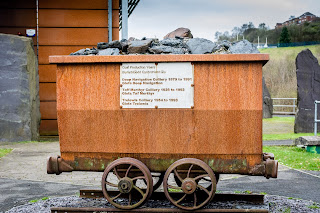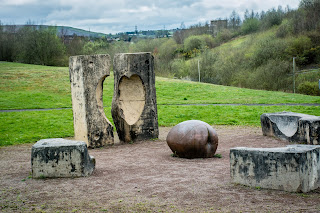So there she stands, my Mam, holding me up for
inspection like a trophy. A two-year-oldish me, in summer dungarees, white
socks and sandals. We stand on the pavement with me looking directly at the
camera and my mum looking at me. She is obviously showing me off and, for the
photographer, I obligingly smile in my
infantile omnipotence. It's probably late afternoon as there are long shadows
on the road and it is possible to make out the shadow of the person taking the
photograph. To our right is a row of terraced houses and to our left its open
with a white house up the road. In the distance is a hill.
This is a photograph that I am familiar with, it
was in the first pages of the scrapbook in which my mother kept the family
snaps. But, I always wondered where this photograph of the young me was taken
as it was not a familiar place. It was not even familiar in that it was a
location that featured in other family photographs.
My mother’s brother Leslie - Uncle Les - lived
in Caerphilly with his wife, Aunty Bet, and it was not until he passed away
that I found out the location of the photograph. As my brother and I went
through his belongings, we came across an old photographic album bound in
leather and there in the album were some photographs of the occasion when my
mother had held me up as a trophy. There was a picture of Les and Bet holding
me at the same spot. The same row of terraced houses, the same pavement, the
same white house in the distance. I
asked Bet’s sister if she knew the location of the photograph.
“That's
where we lived, Bowls Terrace, Penyrheol. When they were first married, Les and
Bet lived with us, me and my mum and dad. You and your mother must've come up
for tea one afternoon.”
The photograph’s occasion is therefore a visit
of a woman to her brother taking her son with her. As my father is not in any
of the photographs, I imagine that this was a trip to Caerphilly that she made
on her own, perhaps on a Saturday afternoon when my Dad was watching football.
The location is Bowls Terrace, Penyrheol.
I knew the general location but not really
this particular row of houses. It is near a very familiar pub known as the
Bowls Inn and obviously it is from this juxtaposition that the terrace got its
name. A brief look at the history books tells you that The Bowls Inn probably
started serving in 1825 and was certainly included in the census of 1841. I
have been unable to find out how it got its name. When I drove past it, I had
always thought it must have been associated with a bowling green, but given its
age it could have been the place where kitchen utensils, bowls, were sold. It
could even have been an English pronunciation of a Welsh word such as ‘bwls’ or
‘pwls’ which is Welsh for ‘pulse’. That would be a good name for an old pub;
somewhere where the pulse of the community could be felt with its health being
measured in the way the local inhabitants interacted or perhaps even the
quantity of beer that they drank. However, the Bowls Inn doesn't exist anymore,
the building is now a convenience store owned by the biggest grocer in Britain,
Tesco; the only measurement of health being indicated by the amount of non-fat
milk and muesli that is bought.
I park in Tesco car park (free parking for
half an hour) and stand in Bowls Terrace trying to put myself in the same
position where Les was when he took the photograph of me and my mother. Someone
is watching. The curtains are twitching. I am there manipulating the picture
and walking up and down trying to relate to ill-defined front garden walls. The
twitching leads to a lady coming out one of the houses.
“Are
you looking for somebody love?” she asks.
“No. Not really” I say, “I have this
photograph of me as a baby and my mother which was taken by here and I'm trying
to find the spot.” I show her the
photograph.
“Good grief. Will you look at that.” She turns
and shows the photograph to a young woman who is now leaving the house holding
a baby a little younger than I would have been. “It's of by here. When would
that have been?”
“Oh,
about 1951.”
“Isn't that amazing. Well well. You carry on,
love.” She turns to her daughter, “We’d better hurry or we’re going to be
late.”
They moved down the road and put a pushchair,
their bags, the baby then themselves into a nearby car. I'm aware of the
busyness of Bowls Terrace now and I relook at the photograph of my mother and
myself. There is something in that photograph which is containing of what is
taking place there now, the cars and the traffic, the new houses , the man on
the mobile phone walking past. But there is not the same element of sanctuary
that seemed to be present on the street when the photo was taken. I know it
cannot be replicated.
Bowls Terrace is on the natural route line of
the River Aber with the road continuing along the valley bottom and turning right at Abertridw - the point where three small rivers merge to become
the Aber. It is also where the now derelict pub 'The Panteg' stands.
 |
| The Panteg, Abertridw |
Not only does the road closely follow the rivers’ path but also that of
the railway line, from Caerphilly, Aber, Penyrheol, Abertridwr, Windsor
Colliery Halt and finally Senghenydd. Obviously, the buildings and rails of
this permanent way ceased in their permanency sometime ago but the route of the
line is still present as the Aber Valley Cycle Pathway. I am on my way to
Senghenydd to visit the Welsh National Memorial to all mine disasters in Wales.
Specifically this memorial commemorates the men that died in the mining
disasters of 1901 when 81 died and 1913 when 439 were killed, the latter being
the worst mining disaster ever in the UK. My father had told me about the
disaster as he had worked with a man whose young uncle died in the event. The
uncle was only 16 years old and got up late that day, and ran down the road to
catch the last cage going down the pit. When they found his body, his shoelaces
were still undone as he had put his boots on in haste.
 |
| War Memorial Senghenydd |
In the middle of Senghenydd village you pass the
War Memorial erected shortly after WWI by the authorities. A different scenario
to the mining memorial for the men killed at work as it was left primarily to
the voluntary efforts of the local community and not being raised until 2013, a
hundred years after the first event. The values and ethics of our profit
orientated society is further demonstrated by the fact that the inquiry that followed the disaster found
that numerous faults could be laid on the managers and the owners of the pit
and they were fined, with the total being the grand sum of £24.00. As one
newspaper at the time commented, that meant that a miner’s life was worth just
‘£0 1s 1¼d’.
When I arrived at the monument the day had
become overcast and the components of the valley landscape, the sky, the rows
of terraced houses and hills above the houses and below the sky had that
monotonous look that grey light brings. At the end of the valley, the site of
the Universal Colliery is bound by a fence of grey metal bars and within its
keeping is now an industrial estate with some empty prefabricated buildings. To
one side of this area of waste ground there is laid out a garden with a couple
of spaces for parking cars. This is the site of the Memorial and on the three
sides where it would have touched the grounds of the colliery there is the
fence as if it is saying this is separate from where it should be. The central feature
of the Memorial is a statue of a rescue worker helping an injured miner.
 |
| National Mining Memorial Senghenydd |
the statue is enclosed is by a small garden boundaried by a wall on top
of which the names are recorded of all the men, some only boys, who died in the Senghenydd
disasters. Underneath each name is their address, the house number, the street
name and the repeated locations of Senghenydd, Abertridwr , Caerphilly with a
smattering of other places. The names and the addresses conjure up the spirits
of the men who lost their lives and as you read each name, each in turn begins the
walk to his home; a walk of doomed
non-arrival, apparent from its first step. From one side of the garden is a snaking path and as you walk along it recorded
on slabs set into the ground are all the disasters in which more than five men
died in the coal mines of Wales. What is not recorded are all the men who died
in pits singularly or in numbers up to 4, nor recorded are all the men who died
slow deaths from injuries suffered underground, neither are the men who were
permanently disabled. Also what is not recorded is the efforts of all the women
who suffered grief, hardship and the caring burden through injuries and deaths
that occurred in the pits. Behind the main memorial and tucked into a corner is a wood carving of a woman holding a baby waiting for news from the pit. An allusion to an iconic image from the time of the 1913 disaster which unfortunately neglects to mention the role of women in the grieving community.
 |
| Waiting for News. The young girl nursing her baby sister form the iconic photograph by W. Benton |
The memorial is very moving and very poignant, but it
is a disgrace. Places in which significant events have happened hold onto
emotions that are linked to that event, indeed the emotion becomes rooted in
that particular location ready to be felt by anyone that allows its arising. At
Senghenydd what arises is the need for recognition, the need to have a presence
and for it to mean something. There it is at the end of the valley and you have
to make a special effort to go there. Such a memorial should recall everybody
whose lives were blighted or cut short in the desire for coal. Such a memorial
should be placed in a position where it is easily seen by the largest number of
people about their daily chores. The mining communities of Wales deserve
nothing less than this and it is a disgrace to call this very poignant, moving
and appropriate memorial to Senghenydd miners the “National Memorial”. What pervades the location is a feeling of 'This is not enough. It is so important it deserves much more than this'. The emotional atmosphere of the desire to be fully recognised surrounds the place.
I walk around the wall of names of the dead; two ghosts arise and set off on
their never ending journey to their homes in Bowls Terrace.
Prowling memories
mute in their demand for
acknowledgement














































